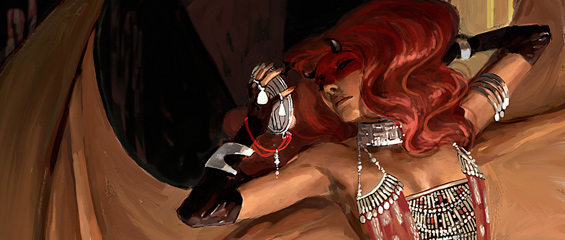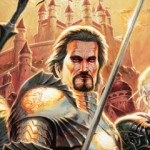Abstraction Elation
 There is beauty in the amount of abstraction that goes into playing 4e D&D. On one hand you have these great things like “combat advantage” that sum up a huge variety of situations with a simple set of words, also things like “sneak attack” and “ongoing damage” work wonders for the imagination and mechanics simultaneously. All these things work, and they work well. At-Will and Daily powers make sense, and they imply instantly recognizeable mechanics to even the newest of players (“Encounter” is another story, and a blog post for another day).
There is beauty in the amount of abstraction that goes into playing 4e D&D. On one hand you have these great things like “combat advantage” that sum up a huge variety of situations with a simple set of words, also things like “sneak attack” and “ongoing damage” work wonders for the imagination and mechanics simultaneously. All these things work, and they work well. At-Will and Daily powers make sense, and they imply instantly recognizeable mechanics to even the newest of players (“Encounter” is another story, and a blog post for another day).
This condensed, streamlined, codified version of D&D that is 4e has truly been its blessing and its curse, I believe it would have been much less of a curse had the original core books did a better job explaining the ins and outs of the game instead of simply implying them. This goes back to something Sersa V and I talked about ton the Haste podcast and how these big companies like WotC need their “What is an RPG” sections and they need to do them damn well. But I’m not talking just this section alone, those books could have done a lot to speak to the reader like a person and lay things out in layman’s terms when it came to running their games. The DMG did a good job of this, the DMG2 did an even better job, the PHB’s…not so much. Problem is, those DMG’s fell into the hands of probably only one fifth of the D&D player base, which is another problem entirely for our hobby. Steve Winter explains it a lot better than I can though, so go have a read.
I’m An Ugly D&D Duckling
I dont know what demographic I fit into for things like this to be honest, because when it comes to games I don’t care about dungeon ecologies or every motivation and biological process that goes into what makes a creature or NPC tick. I don’t care about the lack of logic as to why everyone hides their valuables in underground labyrinths, or the why or how magic plays its part in the world. I certainly could, and would sit around and theorize these things with people, and often do when coming up with campaign settings and such – but when it really comes down to it I could give a shit less about the where, how, and why of all of these questions, and I think my players feel the same.
I play games to have fun, I really do. For me, fun isn’t writing a thesis paper on the logic or reasoning behind how and why a tribe of goblins have thrived for X years and managed to build kingdoms or create trapped pits of spikes 40′ deep and covered them up with a rug. Do your players ever ask “well gee, why would the king guard his precious amulet of undead curbstomping with a meticulous chess puzzle, was chess even part of this world?” My answer is why do we care if we are knowingly just playing a game? Chess is a part of our world, now try solve the puzzle! While this is more of a debate on realism/meta-game, what I’m getting at is – while I don’t normally care about these things, sometimes the amount of abstraction breaks the game down for me when I know I should care less.
Abstraction Distractions
As much as I’m for assuming “combat advantage” could mean a multitude of things, or how much enjoyment I could obtain from a room with a giant chainsaw wielding demon full of traps inspired by Mario Brothers logic – some of these abstractions still bug me. The game starts to break down for me when this happens, and while I’m no stickler for realism in my games I just can’t see justifying certain aspects of 4e’s design. Couldn’t we just have had a section in the DMG explaining how to emulate monster behavior if you really want the “tanking” feel from MMO’s? Wasn’t the “aggro” or “hate” a mechanic invented to do exactly this anyway? Marking targets in D&D was always something that puzzled me, my group has always completely ignored the mechanic and we’ve got along just fine.
How does CHA help a rogue fight? How does CON power a warlock’s pact with otherworldly entities? How does INT affect the religion skill? Why does everything conveniently end on my next turn or when the encounter is over?
Some of these things never quite added up for me, and while I could make an entire blog post about the how and why of my feelings that 4e made ability scores seem like the most trivial aspect of your character sheet, I’ll spare you all and save that too for another post, another day. But the question that remains for me is while some abstractions don’t seem to bother me at all, why do other (possibly less abstract) elements really seem to pull me out of the game? Perhaps I’m immersed in the game, more than the game world?
I’m not asking for or suggesting more simulation, or trying to argue for or against abstraction here. I’m just trying to gauge how much is too much, and I’d like to know other people’s opinions on these things. When (if ever) does the game break down for you? How can we fix things like this possibly heading in to D&DNext? I welcome your thoughts!




Great post, Jerry. I have a ton of responses going through my head right now, but suffice it to say that this is the sort of thing I wish we could sit down & discuss over a few beers.
I don’t think anything is wrong with you, but moreso you have set levels of abstraction that are inherent to what you consider to be a good game. These vary from person to person, and some people like their realism only in certain places.
The tanking bit is a very interesting concept that a lot of 4e haters see as a recent development in D&D. I read a discussion recently on the City of Heroes boards that had an incredible assessment of what tanking is in 4e D&D and how it relates to MMOs:
http://boards.cityofheroes.com/showthread.php?s=b0ef2fd5c39d07aaa6f1d8472dd1e126&p=4160093
Great read. Not necessarily saying I agree with all of it, but it addresses some of your questions about tanking, threat & marking. Maybe it will be of some help.
I’m rambling here but I’ll suffice to say that I don’t think there’s anything wrong with having varying degrees of realism in your wants for the game. My own wants aren’t anywhere near what most modern gamers want, so I don’t talk about them all that much. I’d prefer to have a system that lets me modify how much realism I have in my game & lets me cherry pick what parts of it have the more realistic mechanics.
I think what you’re getting at is that some bits of abstraction are a bit too ‘gamey’. Things that break that wall of immersion for you because they serve to fill more of a mechanical role than they do the story or the setting of the game. Combat Advantage makes sense in a lot of different situations as conferring the same effective mechanical terms (i.e. You have put your target in an advantageous position and will garner some benefits to accuracy/damage/whatever because of it). Some status effect causing powers follow the same kind of path and make perfect sense (A hobgoblin slashing your hamstring would slow you in the similar way that a wizard’s ice lance would slow you down).
However, there are some that don’t have that same amount of flavor that could easily explain the mechanics that they cause. A lot of people have this issue with marks. In my opinion, the function and mechanics of the fighter and paladin marks make sense. The fighter is described as being a master of weaponry and combat, and it makes sense to me why they get to watch their foes and exploit openings when they attack your allies, effectively leaving them open to your follow up attack. The paladin makes a little less sense for me. Yeah, flavor wise it works for their god to smite down the paladin’s enemies… but why does that only happen when the paladin’s foe goes after his allies? Why doesn’t that just happen all the time? The warden and battlemind don’t make a whole lot of sense to me. If the other tank themed classes had justifiable flavor to explain marking/taunting/whatever, then I’d be curious if they’d bother me as much.
I understand the intended role that marks play in 4E and I’m admittedly a big fan of the Defender concept. The idea of being aggressively defensive makes the tank a whole lot more enjoyable to play than a straightforward hit point/AC machine that was prevalent in previous editions. It also leads to some very engaging tactical play that centers around funneling enemy attention and damage toward the defender. In short, it makes the tank fun. I make no excuses that I like some of the MMO flavor that influenced 4E, I think its benefitted how combat plays out really nicely.
I’m with you on the ability scores in 4E though. The modifiers are what matters and you could easily change their name to “Prime Modifier, Secondary Modifier, Tertiary Modifier” and get the same results. It also carried over quite a lot of relics from previous editions that didn’t quite balance out well in 4E. (Dexterity and Con are more powerful than other stats since they influence Surges and Initiative. Strength is very invaluable since only one skill carries off of it, etc).
I feel the same way, I like to cherry pick these things too. Some things I can shrug off and easily find myself alongside whatever logic it is that supports the mechanic but other times…not so much.
That was a pretty good read, that link, always nice to hear video gamer / tabletop RPG players discuss these things, as I too am a hybrid of both types of gamer. Thanks for sharing Jon.
It’s funny, because I was just having this sort of argument with a fellow player the other day about diagonal movement in 4E. It offends him that diagonal movement counts the same as orthogonal movement. “Fireballs aren’t square!” he opined. Whereas I was sitting there thinking, “We have no problem at all with the thousand other approximations required to simulate fantasy combat, but THIS is where we draw the line?”
Things like grid movement, advantage modifiers and combat turns don’t really bother me. (For example, I always assumed that it wasn’t that the fireball was square, but that it’s hard to pin anyone or thing down to a precise location at any given moment, and that “close enough” was good enough.) What *does* take me out of the fantasy is healing surges. I appreciate what the designers were trying to do, but it seems contrived in a way that free diagonal movement doesn’t. (Vancian magic is another example. It might be relevant to *a* fantasy setting, but not any of the fantasy settings that D&D players are likely to want to emulate.)
Healing surges never bothered me, thanks to this article which also inspired me to start my own blog: http://criticalanklebites.com/2010/04/04/wherin-i-debate-4e-and-call-healing-surges-realistic/
Now the problem I really had with healing surges was – players had far too many, and too many opportunities to regain them. Published adventures had too many opportunities for extended rests, this among many other elements contributed to my hatred for 4e PC’s unfathomable ability to never die. However that too, is a blog post for another day. Thanks for stopping by and commenting!
I agree that 4e could have spent more time explaining exactly what “combat advantage” and “marking” mean. However, I don’t understand how your group has just ignored marks — it’s exactly the aggro/tank mechanic you’re talking about, and is integral to the function and balance of the defender classes. It’s what makes the fighter so powerful. It’s a mechanic designed around forcing enemies to either focus on the defender or take a hit.
What puzzled you about marking?
Interesting post.
I’ve been a big fan of 4E, and still remain so – on the rare occasions I get time to play. I like that it’s been largely abstracted, because it gives me room to put details in where I (as player OR as DM) would like.
And then I played in the DnDNext playtest at DDXP – and I didn’t realize that there ARE bits of D&D that really DO seem to be lost in translation to 4E.
Your points about abstration – and how some bits are fine, and other bits feel out of place, I think, boils down in large part to what is being abstracted and how far that abstraction goes.
Combat for example – we abstract down to each person making an “attack” every round – because nobody (that I know anyhow) wants to discuss the blow-by-blow “Ho! Ha ha! Guard! Turn! Parry! Dodge! Spin! Ha! Thrust!” that would fill up the rest of that six second round. Instead, we roll for that one attack that finds a potential opening.
Then there’s fireball. BALL is in the name. A fireball really shouldn’t be square. Call it a firecube, or a firecage, or a firebox – and it becomes (a little) easier to accept. I ~like~ that movement on the grid in 4E is square and simple – but it DOES lend itself to affecting some things that just. . . don’t feel right.
In the end, I’m looking forward to what WotC learns from this, and where they go with DnDNext – I think the idea of making an edition for players of all editions (which I always read as “taking the best part(s) from each version”) will go a long way toward finding a balance between abstraction, game-ism, and narration.
I agree with you on the combat thing, we definitely have been abstracting for far longer than just 4e, I wasn’t trying to say that we weren’t. I definitely see combat itself as an abstraction, unless of course we all start LARP’ing.
But see for me, with fireball, I just assume that is a general area, my minds eye still pictures a circle inside that square, but since the squares themselves are abstract who’s to say a character isn’t standing on the edge of that square? In the center? 5 foot measurements are odd anyway, how often do you see 5′ wide doors or fire places?
Anyway what I’m getting at is, I have this blurred line of things I’m okay with and things that make me go “huh?” and I’m just not sure whether it should bother me or not y’know?
I do look forward to what WotC has learned from this too and I have high hopes for D&DNext so in the meantime I’ll just keep my fingers crossed and my hopes high.
I’m curious if anyone has tried to use DnD on a hexagonal instead of a square grid. Bursts would look like bursts, blasts would look like cones, walls would still be walls. I grew up with GURPS and loved the hex grid that was imployed there, wonder how well it would work for DND.
I normally use hex grid for outdoors, using it for everything indoor just seems weird to me. Hard to explain why though, I’m weird.
I too went through the “streamlining is great!”/”the streamlining is killing me” process. Everyone’s got their line.
For me it was the fact that there is no mechanical support (beyond skill challenges, which are the most abstracted element in all 4E) for social challenges, and no rewards or support at all for roleplaying your character or using your character to drive the story rather than ride the DM’s rails.
Probably most D&D players don’t want all that, but it’s an area where things have been so abstracted that they only exist outside the mechanics of the system. That was my line, once I realized other systems DID provide that kind of support.
Thought-provoking post. It seems for you the game itself might not be streamlined ENOUGH… it has baggage from other editions that make the pure gamer in you say “wait, what?”
Thank you for somewhat nailing exactly what I was talking about in a short post. The “Streamlining is great / Streamlining is killing me” is pretty spot on. Let’s not even talk about skill challenges, yuck! Yeah I really have learned a lot from other systems, enough to houserule my 4e game into my liking but never enough that I could escape all of its hindering bits. Really glad D&DNext is coming out, in the meantime, I’ll cope somehow 😉
Thanks for stopping by and sharing.
Pingback: Healing Surges in 5e, Room For Two?
Pingback: Friday Knight News – Gaming Edition: 23-MAR-2012 | Gamerati